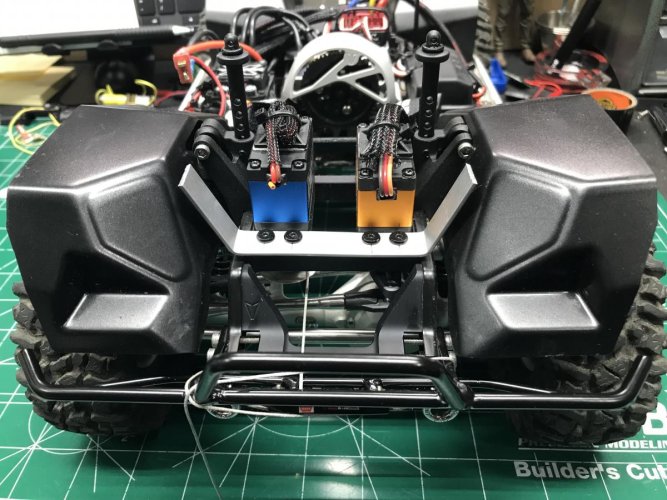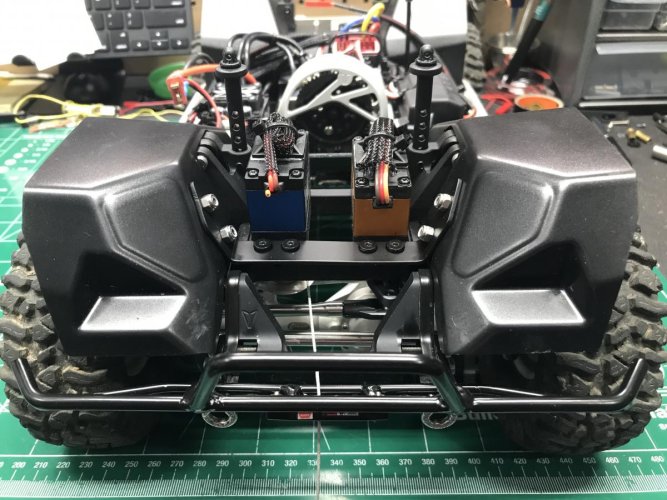Next up for the Origin is to install the inner fenders. I was able to paint them in my basement with Pactra black. This is the first time I'm using Pactra paints. I don't know if it's always been made by Rust-Oleum, but apparently it is now.
I painted these fenders with 3 or 4 heavy coats and I still had light spots. But I figured you shouldn't be really notice them out on the trails so I continued once the paint was dry.

Peeling the protective film off of the inner fenders was a PITA. It kept tearing no matter how meticulous I was. Usually, peeling this film is a fun and satisfying task, but not here. It's an exercise in frustration. I hope the body film isn't like this!

The inner fenders weren't cut as closely to the chassis lines as I expected. Here you can see a relatively large gap between the inner fender and the frame rails. I wish the fit was better all around.
Initially, each inner fender only mounts to the frame on one end using two screws. They are very flimsy and flop around everywhere at this point.
I did have to remove the front bumper here to install the front inner fenders. The aluminum frame brace insert made me think it was OK to install the front bumper at that stage, but you should wait. Not a big deal though as it's only four screws.
You also install the rear bumper while installing the rear, inner fenders.

Here are the great looking sliders with the metal "tabs" attached. These tabs will later be used to locate the sides of the body. The tabs are raw aluminum and they don't match the sliders, but you won't see them once the body is installed.

The sliders oddly have holes in the outsides of them. Two holes on each slider line up with the mounting screws. Without these thru holes you'd have to use a very short driver or an L-wrench so, thankfully, you can use your standard hex drivers here. I'm assuming the need for accessing the mounting screws is what spawned the hole pattern in the sides of the sliders in the first place.

The sliders do look great once installed.

While assembling the chassis you install these two, plastic mounts. I had the foresight to leave them loose knowing that whatever gets attached may not lineup perfectly.

The massive battery and electronics mount is what gets attached the the plastic mounts seen above. I struggled to get those lined up with the battery tray. I had to really loosen the screws that attach those plastic mounts. After I did that everything lined up pretty well. This battery/electronics tray is very sturdy, but I think it's overkill. Plastic with similar thickness would have been just fine. I'd rather the mounts above be aluminum and this tray plastic, but that's just my two cents.

The instructions made me think for a second here because they appear to show another step, but really it just shows the battery tray installed. I can't remember anything else like this in the manual.

The battery tray is also used to mount the other ends of the inner fenders in place. After this, they are fairly sturdy.

The bottom of the floorboards are covered with these plastic pieces that I assume are made from Delrin. They are scratched all to hell out of the package. It's tough to see in the photo, but it looked like somebody had taken sandpaper to mine. It doesn't matter to me because this isn't going to be a shelf queen, but I did find it to be odd.

The manual tells you to attach these Delrin covers or sliders with M3 x 10mm screws, but M3 x 8mm screws were provided in my kit. 8mm is plenty long to attach these covers.

The Delrin covers get attached here to these raw, aluminum mounts on the chassis to which the aluminum sliders attach. Obviously, if you left these mounts uncovered they would be snag points.

This is where I ran into another issue. I must have gotten Monday or Friday mounts because the threads were machined like crap as you can see in the photos below. I do not have an M3 tap on hand (I should), so I had to use an M3 screw and turn it in with lots of force to clean up the threads.


Once I cleaned up the threads, I installed the Delrin covers.

Unfortunately, the fit isn't the best. These pieces aren't wide enough so you have to choose to leave a gap between them and the sliders or them and the frame. I pushed mine up against the sliders.
Also, as you can see here, the holes in the Delrin appear to be drilled too close together and this leads to some warping in the plastic. The Delrin also doesn't sit exactly flush with the bottom of the frame so you have a little lip here. All minor stuff, but I do think it's noteworthy.
Instead of these Delrin covers, I wish they would have integrated them into the mounts or made them wedge shaped to prevent these issues.

At some point while installing the battery tray or Delrin covers I wrecked the one inner fender. As you can see in the photo below, the Lexan spidered and broke clean off around the two mounting screws. I was so pissed off about this. I have no idea how it happened. I do know that there is no way this inner fender would have survived a tumble on the rocks if it couldn't handle being leaned on during the assembly. I am, at the least, partially to blame so I ordered a new set of inner fenders rather than contacting Vanquish.
It will be a semi-PITA the install because it's sandwiched between the slider and battery tray.

After installing all of this stuff, I noticed that there isn't much room between the tire and the slider.
I'm not sure you can get much larger tires on this truck without having to cut the pretty sliders.


In the bag of parts, Vanquish has included this plastic, bumper block off which is nice.

So that's it for now. Again, paint is the holdup. I've found a local guy that I may get to paint this body for me. Stay tuned.
, but the servo horn screw is always Phillips. Does anybody know the reasoning for this? There has to be some history here.


























